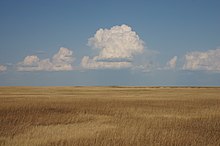prairie

The prairie ( French prairie "meadow", "pasture") is the North American part of the steppe zone of the earth (see: vegetation zone ) . It includes the Great Plains and the western Gulf Coast Plains . Their total extension is around 2.7 million km².
Original vegetation

Move the mouse over the (linked) prairie provinces of Canada and the states of the USA
The limited vegetation (lack of trees, not very dense grass and shrub landscape) is due to the continental location and the rain shadow of the Rocky Mountains and the arid climatic conditions associated with it (lack of water). Especially in the cold periods of the Ice Age was loess been blowing, which is today at the desertification of agricultural overuse ( Dust Bowl repeated).
From east to west there is an increase in altitude and (with the exception of the northwest) a decrease in precipitation. This affects the vegetation in a type series from east to west: The high grass prairie in the east (with andropogon species, up to 2.40 m) - the “prairie in the narrowest sense” - and the northern fescue grass prairie ( fescue grass ) pass over the central mixed grass prairie (1.40 m high grass) into the dry short grass prairie ( Buchloe and Bouteloua species, up to 50 cm) - called " Great Plains ". The damp coastal prairie (Sorghastrum nutans and Schizachyrium scoparium) is also located on the Gulf coast .
Before the settlement by Euro-Americans, huge herds of bison and pronghorn and five billion black-tailed prairie dogs lived here . The most common predator was (and is) the coyote . With the spread of the horse introduced by the Spaniards from the beginning of the 17th to the end of the 18th century, the cultures of the plains Indians developed , whose subsistence was primarily dependent on bison and horse. Even today, some of the largest Indian reservations are in the northern prairie regions of the United States.
Todays use

Today the prairies form a huge agriculturally used, partly deserted and further deserted, often artificially irrigated cultivation area for wheat , maize and other products (see also: Corn Belt ) . Intensive grazing with cattle displaces the grasses and promotes the desert bushes.
The bison, on the other hand, are much better adapted, but were systematically exterminated in the 19th century by white settlers and the military with the exception of a few remains. In 1894, around 800 specimens lived in North America, around 200 of them in Yellowstone National Park as the last wild bison in the United States. Their number fell to only 23 animals by the low point in 1902. From the very beginning, the members of various Indian tribes played a primary role in protecting animals. Between 1992 and 1996 they established around 15 new bison herds, quadrupling the number on Indian reservations. Thanks to the intensive protective measures, there are around 350,000 bison in the American Midwest , a total of around half a million animals (see also: Buffalo Commons ) .
literature
- Prairies , in Meyer's Großes Konversations-Lexikon, Volume 16. Leipzig 1908, pp. 264–265 ( online copy )
- Candace Sherk Savage: Prairies: A Natural History . Greystone Books, 2001, ISBN 978-1-55365-588-6
- Suzanne Winckler: Prairie: A North American Guide . University of Iowa Press, 2004 ISBN 978-1-58729-488-4
Web links
- Roy Robison, Donald B. White, Mary H. Meyer: Plants in Prairie Communities , University of Minnesota website
Individual evidence
- ↑ a b c Richard Pott: General Geobotany. Biogeosystems and Biodiversity. Springer, Berlin, Heidelberg, New York 2005, ISBN 3-540-23058-0 . Pp. 533-534.
- ↑ National Geographic (ed.): Atlas of the wild animals. German edition, National Geographic Germany, Hamburg 2009, ISBN 978-3-86690-117-9 . P. 82.
- ↑ Valerius Geist: Buffalo Nation. History and Legend of the North American Bison. Voyageur Press, Stillwater (USA) 1996, ISBN 0-89658-313-9 . P. 124.
- ^ White Buffalo Hunt Causing Uproar Throughout Indian Country Will Stop , Indian Country, March 7, 2012.
- ↑ Kamil Taylan and Wolf Truchsess von Wetzhausen: The Return of the Buffalo , ZDF film documentary, broadcast date on Arte: January 22, 2008 ( information about the program ( Memento of the original from July 9, 2010 in the Internet Archive ) Info: The archive link was inserted automatically and not yet checked. Please check the original and archive link according to the instructions and then remove this note. )

